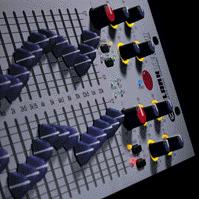- Sound

A common complaint about DJs is that "the music was too loud, we couldn't talk and visit, I couldn't understand what he said on the microphone, and by the end of the night I had a headache".
Good sound is a combination of quality equipment, proper equipment set-up, and applying the principles of acoustics.
Equipment
First you start with good equipment.
“Our DJ, Josh, was extremely professional and kind! Everyone was pleased with the music choices and adults and children alike danced and had an amazing time!” – Katie Ellis
SignatureDJ has two reception sound systems that use top of the line concert sound system components:
- Bag-End TA5000 speakers for the highs
- Bag-End S18 sub-woofers for the lows
- Bag-End ELF processors to time-align the sound
- QSC power amps (bi-amped)
- Rane MPE and Klark-Teknic DN3600 programmable 31-band equalizers
- Rane MP24z and MP44 DJ mixers
- MOTU 828es audio interfaces for the computers
- Shure ULXP receivers with SM58 and Beta87A wireless microphones
Each reception sound system can comfortably work with an audience of up to 400 people. For larger audiences, additional sound system components can be added.
SignatureDJ also has a ceremony sound system that includes:
- Bag-End TA1202 full range speakers
- QSC power amps
- 31-band Klark-Teknic equalizer
- Presonus STUDIOLIVE-16 mixer
- Shure ULXP receivers with SM58 and Beta87A wireless microphones for singers
- Audio Technica AT892 wireless microphone for the pastor
Set-Up
Next, you adjust the equipment correctly.
Proper system set-up involves more than just putting the equipment in place. It involves using the proper test equipment to correctly adjust the system.
Most home stereos have 2 tone controls - treble and bass. Some of the better car stereos have 5-band, or even 10-band equalizers for adjusting the tone. SignatureDJ uses 31-band equalizers for adjusting the tone. Each band of frequencies (from the highest notes to the lowest notes) is properly adjusted to the correct volume level, so the sound is smooth and rich.
When a DJ's sound system sounds "too loud", or it "gives you a headache", chances are that it hasn't been adjusted properly. Your headache is the result of a specific frequency that is playing too loudly compared to all the other frequencies - and that frequency just keeps blaring at you until you have a headache. A fully-adjusted system sounds warm and rich, even when you are standing right in front of the speakers.
Adjusting all the frequencies (from high to low) takes sophisticated test equipment - a Real-Time Analyzer. An RTA plays pink noise (which contains all the frequencies at an equal volume) through the speakers, and then listens to the sound with an analysis microphone. A graph displays the loudness of each frequency, so the equalizers can be adjusted to compensate for those frequencies that are too loud or too soft. The equalizers used by SignatureDJ are programmable so they can store the settings and instantly recall them at the next reception. This means that the sound quality is consistent, night after night.
Acoustics
With quality equipment that is set-up correctly, now it's time to apply acoustic principles to your advantage.
If the audience is having trouble visiting because the music is too loud, it's usually because the speakers aren't positioned properly. The folks on the dance floor want it loud, but the folks that are talking want it soft. The answer to this dilema is speaker positioning.
First of all, the speaker cabinets are placed right next to the dance floor. The closer you are to the speakers, the louder the music will be, and it's the dancers that want the music the loudest.
The speakers containing the high frequencies are positioned at ear level, so you can hear them clearly. Speakers that are positioned below ear level sound muffled, making it difficult to understand what the MC/DJ is saying on the microphone.
The speaker cabinets containing the low frequencies are positioned on the floor. This provides a solid bottom end to the sound that the dancers will appreciate.
Now you're ready to direct the sound where you want it. With the mobile rig, we place the high cabinets on speaker poles, positioned at ear level. During introductions and toasts the speakers point to where the audience is seated, so they can hear clearly. For dance time, they swivel to criss-cross over the dance floor, so the music can be loud for the dancers, but quiet everywhere else in the room. Many DJs make the mistake of positoning the speakers so they play to the entire room - so there is nowhere quiet where the audience can visit.
The sound system at the Petroleum Club includes 4 separate sound systems to provide consistent coverage and control (a separate sound system for the dance floor, the side fills, the southview room, and the hallway). Each sound system is adjusted at specific times of the evening to provide the proper sound balance.
